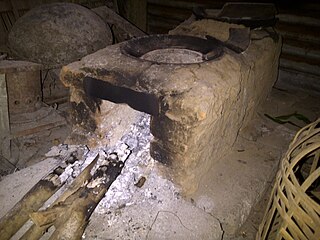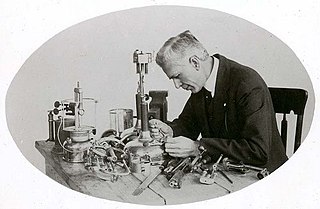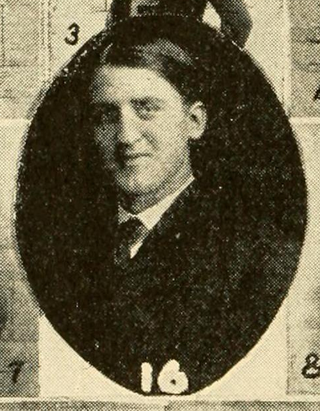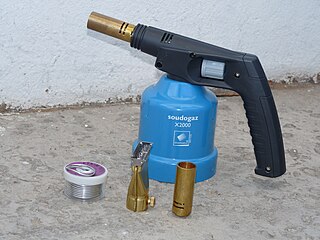Kerosene, or paraffin, is a combustible hydrocarbon liquid which is derived from petroleum. It is widely used as a fuel in aviation as well as households. Its name derives from Greek: κηρός (kērós) meaning "wax", and was registered as a trademark by Nova Scotia geologist and inventor Abraham Gesner in 1854 before evolving into a generic trademark. It is sometimes spelled kerosine in scientific and industrial usage.

Propane is a three-carbon alkane with the molecular formula C3H8. It is a gas at standard temperature and pressure, but compressible to a transportable liquid. A by-product of natural gas processing and petroleum refining, it is commonly used as a fuel in domestic and industrial applications and in low-emissions public transportation. Discovered in 1857 by the French chemist Marcellin Berthelot, it became commercially available in the US by 1911. Propane is one of a group of liquefied petroleum gases. The others include propylene, butane, butylene, butadiene, isobutylene, and mixtures thereof. Propane has lower volumetric energy density, but higher gravimetric energy density and burns more cleanly than gasoline and coal.

A kerosene lamp is a type of lighting device that uses kerosene as a fuel. Kerosene lamps have a wick or mantle as light source, protected by a glass chimney or globe; lamps may be used on a table, or hand-held lanterns may be used for portable lighting. Like oil lamps, they are useful for lighting without electricity, such as in regions without rural electrification, in electrified areas during power outages, at campsites, and on boats. There are three types of kerosene lamp: flat-wick, central-draft, and mantle lamp. Kerosene lanterns meant for portable use have a flat wick and are made in dead-flame, hot-blast, and cold-blast variants.

A portable stove is a cooking stove specially designed to be portable and lightweight, used in camping, picnicking, backpacking, or other use in remote locations where an easily transportable means of cooking or heating is needed. Portable stoves can be used in diverse situations, such as for outdoor food service and catering and in field hospitals.

Liquefied petroleum gas, also referred to as liquid petroleum gas, is a fuel gas which contains a flammable mixture of hydrocarbon gases, specifically propane, n-butane and isobutane. It can sometimes contain some propylene, butylene, and isobutene.

An incandescent gas mantle, gas mantle or Welsbach mantle is a device for generating incandescent bright white light when heated by a flame. The name refers to its original heat source in gas lights which illuminated the streets of Europe and North America in the late 19th century. Mantle refers to the way it hangs like a cloak above the flame. Gas mantles were also used in portable camping lanterns, pressure lanterns and some oil lamps.

A stove or range is a device that generates heat inside or on top of the device, for local heating or cooking. Stoves can be powered with many fuels, such as electricity, natural gas, gasoline, wood, and coal.

A campervan, also referred to as a camper, caravanette, motorhome or RV in North America, is a self-propelled vehicle that provides both transport and sleeping accommodation. The term describes vans that have been fitted out, whereas a motorhome is one with a coachbuilt body.

Campingaz, formerly Camping Gaz, is a brand of products with compressed, mixed butane/propane gas supplied in small, lightweight, disposable canisters and larger, refillable cylinders designed for use as a fuel while camping and caravanning. The fuel gas is compressed to a liquid and sold in characteristic blue metal containers. The brand name is also used on appliances manufactured for use with the gas: cookers, lanterns, heaters, grills, refrigerators, etc. as well as more general camping equipment such as sleeping bags.
Worthington Enterprises, Inc. is a global diversified metals manufacturing company based in Columbus, Ohio. It is a steel processor and manufacturer of pressure vessels, such as propane, oxygen and helium tanks, hand torches, refrigerant and industrial cylinders, camping cylinders, exploration, recovery and production products for global energy markets; water system tanks for storage, treatment, heating, expansion and flow control, and compressed natural gas storage cylinders. The company also manufactures framing systems for mid-rise buildings and steel pallets and racks for shipping. It is the largest independent processor of flat-rolled steel in the United States. The company takes steel from steel producers and processes it for customers in industries including automotive, lawn and garden, construction, hardware, office furniture, electrical control, leisure and recreation, appliance, agriculture and HVAC.

William Coffin Coleman was a businessman, the American founder of the Coleman Company, a maker of camping equipment, and a politician. He served as the Mayor of Wichita, Kansas, from 1923 to 1924.

Willis Sherman "Bill" Bates was an American football and basketball coach. He served as the head football coach at Fairmount College—now known as Wichita State University—from 1905 to 1908 and at Southwestern College in Winfield, Kansas from 1914 to 1925, compiling a career college football record of 81–49–12. He also coached basketball at Fairmount (1905–1908) and Southwestern (1914–1926), tallying a career college basketball mark of 179–79.

The Coleman Lantern is a line of pressure lamps first introduced by the Coleman Company in 1914. This led to a series of lamps that were originally made to burn kerosene or gasoline. Current models use kerosene, gasoline, Coleman fuel or propane and use one or two mantles to produce an intense white light. Over the years more than 50 million of the lanterns have been sold throughout the world.

Coleman fuel, also generically sold as white gas, is a petroleum naphtha product marketed by the Coleman Company.

Butane or n-butane is an alkane with the formula C4H10. Butane is a highly flammable, colorless, easily liquefied gas that quickly vaporizes at room temperature and pressure. The name butane comes from the root but- (from butyric acid, named after the Greek word for butter) and the suffix -ane. It was discovered in crude petroleum in 1864 by Edmund Ronalds, who was the first to describe its properties, and commercialized by Walter O. Snelling in early 1910s.

The G.I. pocket stove is a World War II–era portable pressurized-burner liquid-fuel stove designed by the Coleman Company of Wichita, Kansas, and manufactured by both the Coleman Company and the American Gas Machine Company (AGM) of Albert Lea, Minnesota.

A blowtorch, also referred to as a blowlamp, is an ambient air fuel-burning gas lamp used for applying flame and heat to various applications, usually metalworking.
CADAC, a South African company headquartered in Johannesburg, is a marketer of a wide range of outdoor leisure and patio products designed for durability, portability and convenience.
The 1905 Cooper vs. Fairmount football game was a college football game between Cooper College and Fairmount College played on October 6, 1905, at Association Field in Wichita The game was played at night under gas lamps as a demonstration by the Coleman Company and was the first night football game played west of the Mississippi River. Fairmount won by a score of 24–0.

















